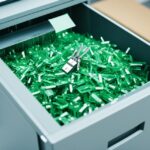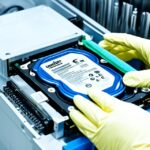Achieving Data Security with Secure Erasure
Secure erasure plays a vital role in data security and ensuring compliance with data protection regulations. Simply physically destroying storage devices is not enough to protect sensitive data. This is where secure data erasure comes into play. It is a software-based method that securely overwrites data on storage devices, making it unrecoverable. With the increasing importance of data disposal and privacy, organizations need reliable solutions like Blancco Drive Eraser to securely erase sensitive data from HDDs and SSDs and ensure compliance with data privacy regulations.
Understanding Encryption
Encryption is a fundamental process in data security that plays a crucial role in safeguarding sensitive information from unauthorized access. By converting plaintext data into ciphertext, encryption ensures that data remains unreadable and protected.
There are two types of encryption algorithms commonly used: symmetric and asymmetric encryption. Symmetric encryption involves using the same key for both the encryption and decryption processes, making it efficient for fast data processing. On the other hand, asymmetric encryption utilizes different keys for encryption and decryption, providing enhanced security.
Various encryption algorithms are employed to implement encryption, each offering different levels of security. Some popular encryption algorithms include:
- AES (Advanced Encryption Standard)
- RSA (Rivest-Shamir-Adleman)
- Triple DES (Data Encryption Standard)
Proper key management is essential for maintaining encryption security. The encryption keys must be stored securely and known only to authorized individuals. Effective key management practices include key rotation, key length optimization, strong authentication protocols, and key storage in a secure cryptographic module.
“Encryption is a powerful tool in the realm of data security, providing an essential layer of protection against potential threats and malicious actors.”
Key Points:
- Encryption converts plaintext data into ciphertext, making it unreadable to unauthorized individuals.
- Symmetric encryption uses the same key for encryption and decryption, while asymmetric encryption utilizes different keys.
- Encryption algorithms such as AES, RSA, and Triple DES provide different levels of security.
- Proper key management is essential for maintaining encryption security.
In the next section, we dive deeper into the process of secure erasure, another critical aspect of data security.
Secure Erasure Explained
Secure erasure is a vital process that ensures the permanent and irreversible removal of data from storage devices. By eliminating sensitive information, secure erasure prevents unauthorized access and mitigates the risk of data breaches. Multiple methods can be employed to achieve secure erasure, including:
- Overwriting: This method involves replacing existing data with random characters, making the original data unrecoverable. Overwriting patterns can vary in complexity, with multiple passes providing a higher level of security.
- Degaussing: Degaussing utilizes a powerful magnetic field to disrupt the magnetic properties of storage media, rendering the data unreadable. This method is commonly used for erasing data from magnetic tapes and hard disk drives (HDDs).
- Physical destruction: Physical destruction involves rendering the storage media physically unusable, typically through shredding, crushing, or incineration. This method ensures complete destruction of the data-bearing components.
The effectiveness of these methods is governed by various standards and certifications that provide guidelines for secure data erasure. The following regulatory frameworks outline the standards and certifications relevant to secure erasure:
- National Institute of Standards and Technology (NIST) guidelines
- Department of Defense (DoD) standards
- Health Insurance Portability and Accountability Act (HIPAA)
- General Data Protection Regulation (GDPR)
The Importance of Erasure Verification
Verifying the success of the erasure process is crucial to ensure data has been securely erased. Organizations can employ various techniques to verify erasure, including:
- Audit trails: Detailed records of the erasure process, including timestamps and the specific actions performed, provide transparency and accountability.
- Certificates of erasure: These documents certify that data has been securely erased, allowing organizations to demonstrate compliance.
- Third-party verification: In some cases, engaging a trusted third party to validate the erasure process adds an extra layer of assurance that data has been effectively removed.
By adhering to recognized standards, employing proper erasure methods, and verifying the results, organizations can confidently protect sensitive data and uphold regulatory requirements.
Why You Need Both Encryption and Secure Erasure
While encryption and secure erasure are distinct practices, they complement each other in creating a robust data security strategy. Encryption shields data during its active lifecycle, safeguarding it from unauthorized access and potential breaches. On the other hand, secure erasure guarantees the permanent removal of sensitive information, eliminating the risk of unauthorized exposure at the end of its lifecycle.
By implementing both encryption and secure erasure, organizations establish a layered security approach that provides comprehensive protection to data throughout its journey—from storage and transmission to disposal. This two-fold approach ensures that data remains secure at all times, regardless of its state or location.
Layered security offers a multidimensional defense against cyber threats, reducing the chances of data breaches and unauthorized access. With encryption protecting data during storage and transmission, and secure erasure rendering it irrecoverable when no longer needed, organizations can confidently safeguard their sensitive information.
Moreover, the combination of encryption and secure erasure helps organizations comply with industry-specific regulations and standards for data protection. Regulatory compliance is vital in today’s landscape, where data privacy regulations, such as GDPR, HIPAA, and CCPA, impose strict requirements on the handling and disposal of personal and sensitive data. By implementing encryption and secure erasure practices, organizations can demonstrate their commitment to regulatory compliance.
In addition to regulatory compliance, the adoption of both encryption and secure erasure mitigates the risks associated with improper disposal of storage devices. Simply discarding or reselling storage devices without properly erasing the data exposes organizations to potential breaches and liabilities. Implementing secure erasure guarantees that data is permanently removed, leaving no traces behind.
“The combination of encryption and secure erasure provides organizations with a comprehensive approach to data security, ensuring the protection, compliance, and risk mitigation necessary in our increasingly digital world.”
To summarize, encryption and secure erasure are two indispensable components of a robust data security strategy. While encryption offers protection throughout a data’s lifecycle, secure erasure ensures that data is permanently removed, minimizing the risk of breaches and unauthorized access. By implementing both practices, organizations create a layered security approach that addresses regulatory compliance requirements and mitigates risks associated with data disposal.
| Benefits of Encryption | Benefits of Secure Erasure |
|---|---|
| Protects data during storage and transmission | Permanently removes sensitive information from storage devices |
| Prevents unauthorized access to data | Minimizes the risk of data breaches and unauthorized exposure |
| Ensures compliance with data protection regulations | Complies with industry-specific regulations for data disposal |
| Guards against cyber threats | Eliminates the risk of improper disposal of storage devices |
Data Sanitization Methods
When it comes to ensuring data security, organizations have various methods at their disposal for data sanitization. Let’s explore the four primary methods:
- Physical Destruction: This method involves physically destroying storage media such as hard drives or SSDs. While it may seem like a foolproof solution, physical destruction is complex, expensive, and harmful to the environment.
- Data Erasure: Data erasure, also known as data wiping, utilizes specialized software to overwrite data on storage devices, making it irrecoverable. This method allows organizations to sell or reuse their devices with peace of mind.
- Cryptographic Erasure: Cryptographic erasure involves encrypting the data on a storage device, rendering it unreadable without the decryption key. Without the key, even if the device falls into the wrong hands, the data remains inaccessible.
- Data Masking: Data masking is a technique that involves creating fake versions of sensitive data, making the original values unobtainable. By protecting the original data, organizations can safely use masked data for testing or development purposes.
Each method offers its own advantages and considerations depending on the specific security requirements of an organization. It’s essential to choose the appropriate data sanitization method based on the sensitivity of the data, compliance regulations, and the desired level of protection.
Comparing Data Sanitization Methods
| Data Sanitization Method | Advantages | Considerations |
|---|---|---|
| Physical Destruction | Ensures permanent destruction of data | Expensive, environmentally harmful |
| Data Erasure | Allows for device reuse or resale | Relies on reliable software and proper implementation |
| Cryptographic Erasure | Protects data even if the device is compromised | Requires secure key management |
| Data Masking | Enables safe use of data for testing and development | Requires careful consideration of masked data usage |
By understanding the strengths and limitations of each method, organizations can make informed decisions when it comes to data sanitization, safeguarding their sensitive information and meeting regulatory requirements.
Data Discovery and Sanitization
Data discovery is a crucial step in the process of data sanitization, as it helps organizations identify and assess the existing data within their systems. By understanding the data sources, data owners, and data flow, organizations can create a comprehensive action plan for data sanitization.
During the data discovery phase, it is essential to identify all potential data sources, including databases, file systems, and cloud storage. This comprehensive approach ensures that no data goes unnoticed, allowing organizations to effectively sanitize all sensitive information.
Once the data sources have been identified, generating comprehensive visualizations can provide valuable insights into data relationships and dependencies. Visualizations can help organizations understand how data is interconnected, enabling them to prioritize data sanitization efforts based on criticality and potential impact.
Creating new datasets can also be a part of the data discovery process. By aggregating and consolidating data from multiple sources, organizations can gain a holistic view of their data landscape and ensure that no data is left behind during the sanitization process.
Data masking is a widely used technique in compliance strategies to protect sensitive data during data discovery and sanitization. It involves obfuscating sensitive information by replacing it with realistic but fictitious data, ensuring that the underlying structure and relationships remain intact.
Data discovery and data masking are integral components of a comprehensive data security strategy. Organizations must leverage the right tools and solutions to uncover and protect their sensitive data throughout its lifecycle.
Data Security Solutions from Imperva
Imperva is a leading provider of data security solutions that help organizations protect their data assets, both on-premises and in the cloud. Their suite of products includes data discovery, masking, and comprehensive data security solutions.
Imperva’s data discovery solution allows organizations to identify and classify sensitive data across their entire IT infrastructure. By pinpointing where sensitive data resides, organizations can prioritize their data sanitization efforts and ensure compliance with data protection regulations.
Their data masking solution enables organizations to obfuscate sensitive data during testing, training, and development activities. By de-identifying sensitive information, organizations can continue to derive insights from their data while minimizing the risk of unauthorized access or exposure.
Furthermore, Imperva’s comprehensive data security solutions provide organizations with end-to-end protection against data breaches and unauthorized access. Their advanced threat detection and prevention capabilities safeguard data in both on-premises and cloud environments, ensuring that sensitive information remains secure.
To learn more about Imperva’s data security solutions and how they can help your organization achieve robust data sanitization and protection, visit their website.
Conclusion
Ensuring data security is of utmost importance in today’s digital landscape. Incorporating both encryption and secure erasure into data management practices provides a comprehensive approach to safeguarding sensitive information throughout its lifecycle. Encryption protects data during its active use, while secure erasure ensures that data is permanently removed when it is no longer needed. By implementing these two methods, organizations can create a layered security approach that mitigates risks and maintains regulatory compliance.
Reliable solutions like Blancco Drive Eraser and Imperva offer effective data security measures, including encryption and secure erasure, to protect sensitive data from unauthorized access and ensure compliance with data protection regulations. These solutions provide organizations with the means to securely erase data from various storage devices, such as HDDs and SSDs, and offer error-free, certified erasure reporting. By choosing trusted solutions, organizations can rest assured that their data is protected throughout its entire lifecycle.
Benefits of Encryption and Secure Erasure:
- Data Security: Encryption and secure erasure work together to provide robust data security measures, protecting data from unauthorized access and ensuring its confidentiality.
- Regulatory Compliance: Implementing encryption and secure erasure helps organizations meet regulatory requirements and maintain compliance with data protection regulations, such as GDPR, HIPAA, and industry-specific standards.
- Risk Mitigation: By employing both encryption and secure erasure, organizations can mitigate the risks associated with data breaches, unauthorized access, and improper disposal of storage devices.
- Comprehensive Data Protection: The combination of encryption and secure erasure offers a comprehensive data protection strategy, covering data at rest, in transit, and data disposal.
Whether it’s securing data during its active use or securely removing it at the end of its lifecycle, encryption and secure erasure play vital roles in protecting sensitive information. By utilizing reliable solutions and following best practices, organizations can safeguard their data, maintain regulatory compliance, and minimize the risks associated with data breaches and cyber threats.
Trust Blancco Drive Eraser and Imperva for reliable data security solutions that prioritize encryption, secure erasure, and regulatory compliance. Safeguarding data is essential in today’s data-driven world, and investing in robust data protection measures is an imperative for all organizations.
Server Recycling UK
Proper disposal of servers and other IT assets is crucial to prevent unauthorized access to sensitive data. When it comes to server recycling in the UK, IT-Recycle offers secure and environmentally friendly solutions. With their expertise in data security and privacy, IT-Recycle ensures that all data stored on the recycled servers is securely erased before the recycling or repurposing process begins. By choosing IT-Recycle, you can have peace of mind knowing that your sensitive information will be handled responsibly and in compliance with data privacy regulations.
IT-Recycle’s commitment to environmental sustainability sets them apart. By recycling servers instead of sending them to landfills, they contribute to minimizing the impact on the environment. This responsible approach to server recycling aligns with the growing need for businesses to prioritize sustainability and reduce electronic waste.
When it comes to the security and protection of your data, trust IT-Recycle’s reliable server recycling services. Visit their website to learn more about their secure and compliant server recycling solutions in the UK.
FAQ
What is secure erasure?
Secure erasure is the process of permanently and irreversibly removing data from storage devices to prevent unauthorized access to sensitive information.
Why is secure erasure important?
Secure erasure is important for achieving data security and complying with data protection regulations. Simply physically destroying storage devices is not enough to protect sensitive data.
What is encryption?
Encryption is a process that converts plaintext data into ciphertext using mathematical algorithms and encryption keys to ensure that data remains unreadable to unauthorized individuals.
What are the two types of encryption?
The two types of encryption are symmetric encryption (using the same key for both encryption and decryption) and asymmetric encryption (using different keys for encryption and decryption).
What are some common encryption algorithms?
Common encryption algorithms include AES, RSA, and Triple DES, which provide different levels of security depending on the specific needs and requirements.
Why is key management important in encryption?
Proper key management is essential for maintaining encryption security and ensuring that the encryption keys are securely generated, stored, and distributed.
What are the different methods for secure erasure?
Different methods for secure erasure include overwriting, degaussing, and physical destruction, each offering varying levels of security and irreversibility.
What standards and certifications govern secure data erasure?
Standards and certifications like NIST guidelines, DoD standards, HIPAA, and GDPR govern secure data erasure, ensuring compliance with industry-specific regulations.
How can the erasure process be verified?
The erasure process can be verified through techniques such as audit trails, certificates of erasure, and third-party verification to ensure that data has been securely erased.
Why do you need both encryption and secure erasure?
Implementing both encryption and secure erasure creates a layered security approach that protects data during storage, transmission, and disposal, mitigating risks and ensuring compliance with regulatory standards.
What are the primary methods for data sanitization?
The primary methods for data sanitization are physical destruction, data erasure, cryptographic erasure, and data masking, each addressing different needs and requirements.
What is data discovery?
Data discovery is the process of identifying existing data in an organization, generating visualizations, and creating new datasets to develop an action plan for data sanitization.
What is data masking?
Data masking is a widely used technique in compliance strategies that involves obfuscating sensitive data to protect its confidentiality and comply with data protection regulations.
Who provides data masking and data security solutions?
Imperva provides data masking, data discovery, and comprehensive data security solutions that protect data on-premises, in the cloud, and in hybrid environments.
Why is server recycling important?
Server recycling is important to prevent unauthorized access to sensitive data and comply with data privacy regulations when disposing of IT assets. Trust IT-Recycle for secure and environmentally friendly server recycling solutions in the UK.















